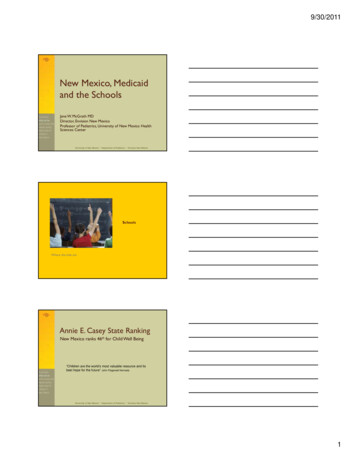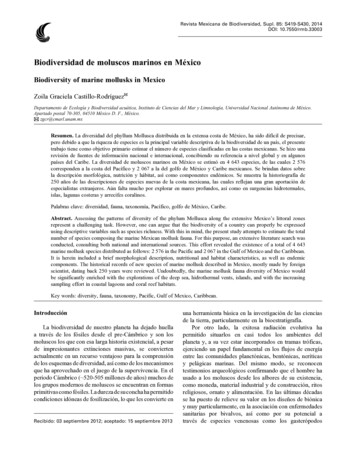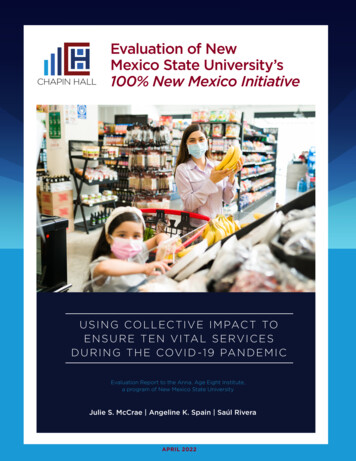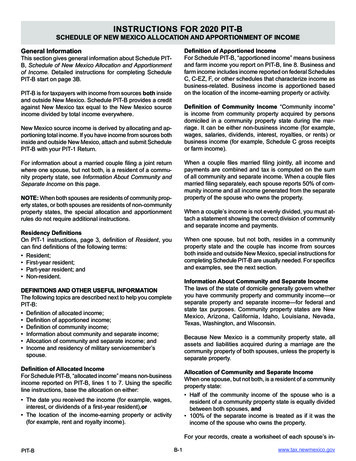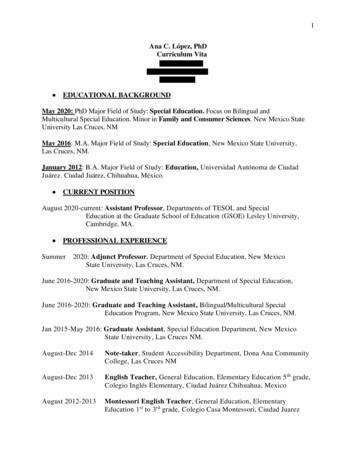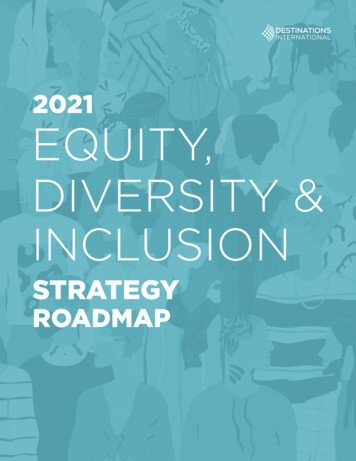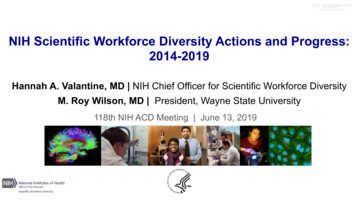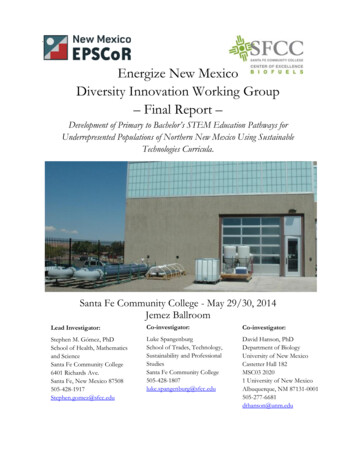
Transcription
.Energize New MexicoDiversity Innovation Working Group– Final Report –Development of Primary to Bachelor’s STEM Education Pathways forUnderrepresented Populations of Northern New Mexico Using SustainableTechnologies Curricula.Santa Fe Community College - May 29/30, 2014Jemez BallroomLead en M. Gómez, PhDSchool of Health, Mathematicsand ScienceSanta Fe Community College6401 Richards Ave.Santa Fe, New Mexico 87508505-428-1917Stephen.gomez@sfcc.eduLuke SpangenburgSchool of Trades, Technology,Sustainability and ProfessionalStudiesSanta Fe Community College505-428-1807luke.spangenburg@sfcc.eduDavid Hanson, PhDDepartment of BiologyUniversity of New MexicoCastetter Hall 182MSC03 20201 University of New MexicoAlbuquerque, NM 87131-0001505-277-6681dthanson@unm.edu
SummaryThe U.S. Department of Education recently declared “an absolute priority aimed at improvingscience, technology, engineering, and mathematics (STEM) education.” “This priority aims toultimately improve student outcomes by supporting projects that are designed to rapidly improvelow-performing schools and, when appropriate, their feeder schools.” (Federal Register, April 23,2014). According to data from the Bureau of Labor Statistics, in May 2009 the average annual wagefor all STEM occupations was 77,880 which is nearly 79% higher than the national average for alloccupations. Only 4 of the 97 STEM occupations had mean wages below the U.S. average. A 2010National Academy of Sciences study documented a 5.5 percent decline in the number of science andengineering degrees being awarded to U.S. citizens and permanent residents and projects a shortageof scientists and engineers starting as early as 2015. The problem is exacerbated by national securityregulations that sharply limit how many foreign nationals can attend American universities or areeligible to fill these key jobs.Many Northern New Mexico school districts have low graduation rates (average 53%) and havesome of the lowest math proficiency scores in the state. The majority (75%) of the studentpopulation at Santa Fe Community College (SFCC) is over 25 years old, indicating that SFCC is a reentry point for students into the educational system. While older returning students are moremotivated to get an education, these returning students have many extra challenges to completingtheir degree or certificate programs; i.e. deficiencies in math and English skills, deficiencies in studyskills, young children, divorce, multiple jobs and probation, to list a few. Younger students who areengaged and encouraged to complete high school greatly improve their chances of success at college.Keeping young students in school until they graduate and continuing to college, instead of returningat a later date with extra burdens, is a main objective of this Diversity Innovation Working Group(D-IWG).The Biofuels Center of Excellence at SFCC provides a STEM-based education focused on 4-yeartransfer degrees, or career pathways to the sustainable technology industries of New Mexico. SFCCis a Hispanic Serving Institution (HSI) for federal funding purposes and is a minority-majorityinstitution with a high percentage of 1st generation Hispanic and Native American college students.Sustainable Technology is an excellent means of introducing STEM to non-traditional students dueto the perception among students that it is not a STEM-related program. During its four yearexistence, 95 students have enrolled in the Biofuels program, 9 have continued on to STEM fields ata 4-year university, 5 have been employed in the biofuel/algae industry and 7 have createdbusinesses employing 22 people in the Santa Fe region. SFCC “walks the walk” when it comes tosustainability. The campus generates most of its own electricity and heat via solar and biomassenergy and nearly all degree programs have a sustainability component.The D-IWG explored extending the Biofuels program to northern NM rural/tribal schools (K-12)in order to engage young students in “hands-on” citizen science and math activities. The activitieswould continue through high school directing students to SFCC for the first two years with aseamless transfer to UNM or NMSU to complete their Bachelor’s degree. The D-IWG broughttogether vested individuals from SFCC, UNM, NMSU, ENMU, U. Wisconsin – Stevens Point,Tesuque Pueblo, NCGR, LANL/NMC, SNL, US Army Corps of Engineers, Girl Scouts, NMMESA, private industry, NM-PED and representatives of Senators Heinrich and Udall to develop apathway for entry and retention of non-traditional students in STEM education and to identifyfunding sources.The 1.5 day workshop was split into a ½ day session on Thursday and full day on Friday. TheThursday session provided an opportunity for all the participants to give short talks on sustainability
or educational components at their institution that could be a part of the STEM pathway of theproposal. The Friday working groups were preceded by two talks on laboratory design and teachingmethods for non-traditional students at community colleges; two short talks by current SFCCSustainable Technologies students on projects that they have initiated in Puerto Rico and JemezPueblo as a result of class projects and the final talk was about the Professional Science Masters(PSM) degree as another option for students to pursue. The last topic generated considerableinterest among the participants. After the PSM talk, “MS to MS” (Middle School to Masters ofScience) was proposed as the slogan for future workshops.ResultsThe most immediate and pronounced result of the D-IWG was getting representatives of the 4-yearuniversities and national laboratories to be physically present at the SFCC Biofuels Laboratory.Nearly all the participants were aware that there was an Algal Biofuels Program at SFCC, but nonewere aware of the scale of the program or the scale of the cultivation equipment in the lab. SFCCprovides the opportunity for the universities and national labs to scale up the production of novelalgal strains on equipment they do not have at a very low cost. Several possible collaborations werediscussed during the workshop and are listed in the appendix.The proposed topic of the D-IWG was to offer “hands-on” STEM education/community programsthat will engage young students in sustainable technology science by using a proven program in algaeprospecting and characterization. The program for younger students will be to expose them toopportunities for higher education, self-sustainability and community impact. Over the duration ofthe working group and after tours of the sustainable technologies facilities at SFCC, the topicsbroadened and eventually settled into two general areas of discussion; A program to generate interest in northern NM middle and high school students insustainable technology careers that require STEM education.A program for transfer of students from SFCC to 4-year universities and how to addressmajor roadblocks, including:o Provincialism and the reluctance of SFCC students to leave Santa Fe or nearbycommunities, even temporarily, to pursue education elsewhere.o The lack of transferable courses in Sustainable Technologies and/or the lack of 2x2articulation agreements between SFCC and the 4-year universities.o The low number of women in the Sustainable Technology program.I. Stealth-STEM in Middle and High schoolsBiofuels is perceived as a “tree-hugger” program that tends to attract non-STEM degree seekingstudents. At SFCC the Biofuels program has been referred to as “stealth-STEM”. The approach isto let students enter the program, immerse them in a laboratory-based hands-on curriculum and“discover” that math and science are integral to their success. Entering students have little interest inthe required STEM courses, but by the 2nd semester are in a panic when math and science classes areclosed. SFCC Biofuels students change from “I hate science” to “Should I take chemistry or biologyfirst?” in a very short period of time. By the very nature of the student population at SFCC manymay still require remedial courses, especially in math. For such an approach to succeed, studentsstarting the programs must be exposed to material relevant to their degree. Their perception ofrelevance is very important in keeping them engaged, especially when the material becomes difficult.In order to make the high school to college transition less terrifying, we propose to set up a verticaleducational program using demonstrated biofuels curricula to engage students early. The aim of thisD-IWG is to extend this approach to the public school system to attract students into math and
science before college by letting them discover that math and science are an integral part of theirfuture career goals.The title of the working group describes the use of algae prospecting to engage students, but theultimate goal is not to solely teach algae cultivation. The model that the working group started withwas the Backyard Biofuels program iofuelsCitizen-Scientist-Project) run by the St. Louis Science Center and the Donald Danforth PlantScience Center. The program culminated in a conference called “Algaepalooza” where all theparticipants had the opportunity to present their discoveries. A local citizen-scientist model that wasdiscussed is Bernalillo County Open Space Division’s Get Involved Project(http://www.bernco.gov/get-involved-3998/). Algae prospecting/cultivation is used as a “hook” toget the students involved and then introduce them to the broader topics of water, climate change,food security, carbon-, nitrogen- and water cycles. The working group concluded that the othersubject areas of the Sustainable Technologies program at SFCC are equally “interesting and exciting”for using as “hooks” for STEM education. The areas include solar power (photovoltaic and solarthermal), aquaponics/hydroponics/sustainable greenhouse management and water/wastewateroperations.Any curriculum developed would need to both engage students with hands-on activities and meetthe NM State Standards, including the Common Core for math and literacy and the NextGeneration Science Standards. The current state of public education in NM in relation to theCommon Core curricula may make it difficult to implement any new programs in math or scienceclassrooms due to reluctance on the part of school systems to modify already approved curricula.Integrating the sustainable technology curriculum into the science classroom would be the idealchoice, but the consensus of the working group is that afterschool or summer programs would be abetter/easier approach to get stealth-STEM into the K-12 school systems. Afterschool programwould require additional funding, but would allow the implementation of STEM-based sustainabletechnology modules in a fairly rapid time frame with a minimum of administrative hurdles.There was considerable discussion about the target geographic location, target age group, targetethnic/economic group and final educational outcome. Although the proposal was to pilotprograms in rural/tribal schools, the consensus was that the Santa Fe Public Schools should be theinitial school system for the following reasons: The Santa Fe Public School system has among the lowest graduation rates and mathproficiency scores in the stateThe close proximity would allow for better use of initial funding towards curriculumdevelopment, instead of travelo High school students would have easy access to the SFCC Biofuels labo SFCC students would be more readily available to function as mentors at themiddle/high schoolsSanta Fe Public Schools requires each student to take an honors, an advanced placement(AP) or a dual-credit course in order to graduate. SFCC’s BCX Biofuels curriculum is alreadyapproved dual-credit with the Santa Fe Public School systemSFCC has already offered the BCX program to Masters Program students (a charter highschool of the Santa Fe Public Schools housed within the SFCC campus) with great success.SFCC and Santa Fe High School (SFHS) are partners the Academy of Sustainable Education(ASE) at SFHS.o ASE a new in-school academy at SFHS starting in the 2014/15 school year.
o 300 students (68 seniors) in grades 9-12 have enrolled in the academy – out of 1500total enrollment, indicating that the students have considerable interest in learningabout sustainability and a sustainable life-style.o SFCC is currently training the ASE faculty in the BCX curriculum to be used at theAcademy.o Many of the courses in ASE are dual-credit. When ASE students receive their highschool diploma, many will also have a SFCC certificate in Sustainable Technology,while the more ambitious may have a SFCC AAS degree in Sustainable Technology.Afterschool or Summer ProgramsSeveral local organizations, including existing afterschool programs and school-based clubs could bepossible hosts for STEM programs. These organizations have considerable experience in runningprograms for early education and intervention and are ideal partners for the early stages in thesustainable technology pathway to college. The organizations identified to partner with (but notlimited to) are: Girl Scouts of New Mexico TrailsNM MESABoy Scouts – Great Southwest CouncilBoys and Girls ClubsGirls, Inc.Municipal/County Afterschool/SummerPrograms 21st Century Afterschool Programs4-HFuture Farmers of AmericaMuseumsZoos/Aquariums/Botanical GardensLibrariesSome of these organizations would target K-5 students, others middle to high school students andothers cover the entire K-12 age populations. These organizations make extensive use of peer-topeer education which further reinforces the lesson that STEM education is valuable for their future.NM MESA and the Girl Scouts already have implemented rigorous STEM curricula in theirprograms. SFCC would provide: Campus open houses and family days as a culminating event offered to schools that participatein the program. The more access students have to the campus the better! Student guest speakers to occasionally visit schools and share their work. Content experts and access to specialized equipment.Most museums and libraries are not tied to the same standards as schools and can be more flexiblein programming. They may be able to host or offer similar programs as those for schools, but withfewer restrictions. Examples of programs that are offered by local museums: Santa Fe Children’s Museumo Weekly programs in literacy (some bilingual) and hands-on art activitieso Explorer’s Summer Camps (week long camps in STEM areas)o SFMaker’s Workshop (800 ft2 workshop for 8-14 yr olds. Open to additionalprojects. Opportunity for introducing biofuels/sustainability workshop)El Rancho de las Golondrinaso Opportunities for workshops/camps that teach and compare traditionalagriculture to modern agriculture, incl. greenhouse cultureRio Grande Nature Center State Parko Offers educational programs in ecology and natural systems.
o NM State Parks has the Kids 'n Parks Transportation Grant Program to providefunds for buses. Teachers must connect classroom learning to the outdoors andmust evaluate their experiences.Los Alamos National Laboratory – Bradbury Science Museumo Algae to Biofuels: Squeezing Power from Pond ScumSeveral museums in the Albuquerque area offer STEM programs including;o New Mexico Museum of Natural History and Scienceo Explora Science Center and Children’s Museumo National Atomic Museumo National Hispanic Cultural Centero Albuquerque Biopark (Zoo/Aquarium/Botanical Garden)Ideally, a long-term program is created that re-engages the same students over the course of their K12 experience and reinforces their knowledge that a college education is a desirable and achievablegoal. Introducing a college degree as a goal is especially important for potential 1st generation collegestudents who have not been exposed to the benefits of higher education. The proposed projectwould involve algae bioprospecting, but could also be coupled to SFCC programs in sustainableagriculture/greenhouse cultivation, solar projects or water projects. A tracking study to determine ifthe program is effective should be matched with a College of Education at UNM, NMSU orNMHU. This main program goal should be to develop an integrated vertical STEM educationpathway from elementary school through a Bachelor’s degree using sustainable technology curriculacoupled with effective tracking studies.Kindergarten – Fifth gradeElementary schools do not have dedicated science teachers on staff. Some school districts havetraveling science teachers that may visit a few times a month. Afterschool programs are probably thebest mechanism for more frequent interaction with students. NM MESA and the Girl Scouts haveconsiderable experience in funding/managing these types of programs. These programs shouldinspire and encourage science engagement with short, hands-on, “splashy” results type of activities. Series Program – weekly or monthly sessions, that will engage children for four to six weeks.This can be done as part of the school day or in an afterschool program.Two part events – visit identified schools twice a year, spring and fall. If using BackyardBiofuels as a model, have children collect specimens in fall and have a follow-up session toexplore what they have learned and report back on findings in the spring.Family Science Nights – Provide a program for the entire family that involves stations andfood. This will expose children and parents to STEM opportunities and reinforce theperception of SFCC as part of the community.Sixth – Twelfth gradeMiddle and High schools have dedicated science teachers. These teachers should be offeredcontinuing education credit for participating in sustainable technology training workshops/courses.These teachers that have completed the training would be able to introduce students to more indepth sustainability topics and reinforce academic concepts taught in the science classroom.Students will complete engaging hands-on activities that increase academic proficiency for futureSTEM engagement and academic success. Areas where the SFCC Sustainable Technology programcould contribute include:
Sustainable technology training for science teachers.Transfer the BCX Biofuels Curriculum to High School science grants/product/2584)Regular meetings that engage middle school students in biofuel science. Led by a paidfacilitator, perhaps school staff or SFCC intern. This would follow the NM MESA modeland involve consistent engagement by students from elementary school through high schoolthat require students to prepare regular written reports on their projects.Day camp program that includes the same ideas as above, but is a condensed week longprogram.Farm to Fork Program that includes compost and biofuel generationo either as part of science education or afterschool clubo greenhouse/hydroponic food production on unused space at middle/high school several middle schools in the Albuquerque Public Schools use greenhouses aspart of the science curriculum and afterschool programso biomass or bio-digester could be built at each high schoolo program can be expanded to include energy educationo food waste education – food waste should go to compost/biogas, not landfillEnergy education in high schoolSummer Institutes -Supplemental for ninth-twelfth gradeStudents will explore STEM/Sustainable Technology topics during in-depth Summer Institutes atSFCC. These Institutes will include ACT/SAT preparation courses for high school students. Theseprograms will be three to four week camps at SFCC (or UNM, UNM-branch campuses, NMHUand NNMU) that engage students in considering career opportunities and STEM education, as wellas, expose them to college life and share how a college education can change their lives andcommunities. Biofuels Institute – The summer course will expose students to Biofuels Technology andAlgae Cultivation. During the summer the students will become exposed to energy, waterand carbon cycle issues and their impact on the students and their community.Agriculture Institute - The summer course will expose students to Aquaponics Technology,Hydroponics Technology and Sustainable Greenhouse Agriculture. During the summer thestudents will learn biology and chemistry and be exposed to food security, land use, wateruse, social justice issues and their impact on the students and their community.Water Institute – The summer course will expose students to Water Conservation, WaterTreatment technologies, Wastewater Treatment technologies, Rain water catchments andBiology of water systems. The program is heavy in chemistry and biology.Solar Institute – The summer course will expose students to the various aspects of solarenergy including; Passive solar heating, Solar thermal heating, Photovoltaic power generationand community based solar projects. The program includes introductory geometry andoptical physics. Advanced math concepts are introduced as part of the solar project.Farm to Fork to Fuel ( in development at SFCC) – The Greenhouse Management Programand the Culinary School at SFCC are developing a Farm to Fork summer program. TheBiofuels program is developing the “to fuel” content to include into the program. Theprogram is an 8 week summer course targeted to students who do not have the ability toattend the usual summer camps in the area. 1 week will be devoted to introducingsustainability, 2 weeks each to greenhouse cultivation, biofuel production and culinary arts.Daily math and science tutorials will be held and concepts such as; Life Cycle Analysis,
Water Conservation, Carbon Footprint, Recycling and Biofuel Production will be continuallyreinforced. The final week will be devoted to preparation of the “harvest banquet” wherestudents prepare and serve the food they grew to their parents and families. Weeklymovie/planetarium nights are to be included for the students and families.Summer Research JobsA barrier to completion of high school, possibly unique to the Hispanic population, is the culturalbelief in being a “good worker”, not necessarily a “good student”. Retention can be difficult if thechoice is between staying in high school (having to trust the teachers that graduating will increaseyour income), or taking an immediate construction job that pays 15- 25 per hour. Many of thesestudents have the self-perception that they are only smart enough for manual labor. One of the besttools the Biofuels Program has used to keep these at-risk students in the program is to offer paidsummer internships that require some research project on the part of the student. The realizationthat they can get paid for doing research using their STEM education is an “eye-opening” experiencefor many of them. Paid summer internships for at-risk high school students would “open eyes”much sooner. This program would be a longer term goal, hopefully including local sustainableindustries to provide internships. Long-term funding needs to be obtained in order for the programto succeed with students and local businesses.Long-term ProjectsNM AlgaepaloozaCreation of an annual NM Algaepalooza style event for bio-prospecting would be a great success forthe D-IWG. Various ecological systems would be targeted in different years including; the Bosque del Apache (a major flyway) during and between migrations;o to assess introduction of new species carried by migrating birds various rivers systems above and below treated wastewater discharge pointso to measure the change in algal populations after introduction of treated wastewater a survey of the various hot springs in NMo to find extremophile algae that can withstand high temperature and mineral content wastewater retention ponds from mining, hydraulic fracturing, and municipal runoffo to find algae that can survive in high metal content or extreme pH environments a range of other extreme or unique environments across the state.These samples could by analyzed for potential use as biofuel (lipid or carbohydrate based),bioremediation (to clean metal contamination or to lower salinity), nutritional value for both humansand livestock or simply to create a database of algal markers to monitor movement of species intothe state. This program would involve elementary and middle school students, at the collecting end,all the way to graduate students at universities and postdocs at national laboratories, at thecomprehensive analysis end. Web-based access and videos would be available to all participants tofollow the progress of their sample. Ideally, each of the “steps” should be in place and demonstratedbefore approaching the federal government for long-term funding.Heritage Energy ProgramThe Biology Department at UNM envisions developing a Heritage Energy program betweenTesuque Pueblo, UNM, SFCC and others. This exchange program would have students from thevarious institutions participate in the Tesuque seed bank program learning to grow heritage plants insustainable ways. Studies would produce data on agronomic, physiological, genomic andmetabolomic properties of heritage plants grown in a sustainable manner. The data would beanalyzed to understand how heritage plants have unique, or unusual, physiologies that may be useful
for world agricultural or for energy needs (i.e. why preserving heritage lines is essential for ourfuture). The heritage plants would be harvested for seeds (to maintain viable seek banks) and alsofor energy and food activities. Bagasse left over from harvest would be put into the SFCCbiodigester to produce biogas. The students who worked on the Tesuque farm would burn this gasin a grill at SFCC to cook the harvested edible parts of the heritage plants they grew during thesummer. Preserving Tesuque’s cultural heritage by teaching new generations about traditionalfarming practices and traditional recipes using modern sustainable technologies would educateeveryone on the importance of the heritage varieties and demonstrate that environmentallyresponsible agriculture is possible. It is also possible to develop a related Heritage Aquacultureprogram using native fish and plants in the aquaculture greenhouses at SFCC. The connectionwould be made as to why preserving the heritage lines and growing methods is essential forpreserving culture.Model Program - The Detroit Area Pre-College Science and Engineering ProgramThe Detroit Area Pre-College Engineering Program (DAPCEP - http://www.dapcep.org/) is nonprofit that annually provides more than 4,000 preK - 12th grade students with hands-on exposure toSTEM topics through in-school and out-of-school educational programs. DAPCEP has a 38-yeartrack record of motivating minorities to pursue careers in STEM fields. DAPCEP offers high-qualityprogramming in many areas including renewable energy. Partnerships with 8 Michigan universities tooffer Saturday science and math classes to 4th-12th graders during the school year, as well as summercamp sessions, have been in operation for several years. Approximately, 60% of students attendingthe summer engineering academy at the University of Michigan School of Engineering applied toand were accepted by the school. Of those surveyed, 80 % of alumni affirmed that DAPCEPprepared them for higher education and careers in STEM fields and medicine. DAPCEP has a largepool of funders including; the Detroit Public Schools, NSF, Michigan Dept. of Education, BigBrothers/Big Sisters, GM and Ford Foundations and the UAW. This is a model system that shouldbe established in New Mexico in the near future.Model Program – Boston Area Girls STEM CollaborativeThe Boston Area Girls STEM Collaborative (http://www.bostongirlsstem.org/) was created in 2008by local nonprofits, universities and museums united in their commitment to advocate for girls'participation in STEM areas. The Collaborative develops and implements programs for girls to learnabout current research, interact with female role models, and access STEM information andresources. Members of the Collaborative include: Ben Franklin Inst. of Tech., Boston U., EmmanuelColl., Harvard U., M.I.T., Northeastern U., Simmons Coll., UMass Boston, Wentworth Inst. ofTech., WGBH. Biogen Idec, Girl Scouts of Eastern MA, IBM, the Microsoft NERD Center and theSociety of Women Engineers. During the academic year several one-day events are held were girlscan learn about cutting-edge research and careers first-hand from women in science and engineeringat multiple sites in the Boston area. During the summer several “science camps” are held for middleand high school girls in various disciplines at various institutions depending upon the girl’s interest.While New Mexico does not have the same density of college and universities as Boston, there areseveral world class laboratories that could participate with NM colleges and universities in a similarcollaborative, namely; Sandia National Laboratory, Los Alamos National Laboratory, New MexicoConsortium, USAF Phillips Research Laboratory, White Sands Missile Range, National RadioAstronomy Observatory’s Very Large Array, the Corps of Engineers, US Fish and Wildlife Service,US Bureau of Reclamation and WIPP. This model could be followed for girls, Native students,Hispanic students or even more narrowly defined groups. The low numbers of women in STEMfields could be changed in the long term if young girls are encouraged and shown that they canparticipate in STEM activities just as well as the boys.
Model Program – O'Keeffe Art and Leadership Programs for Girls and BoysThe Georgia O’Keefe Museum Art and Leadership Programs for Girl and Boys are gender-specificcamps for adolescent girls and boys, 11-13 years,
Stephen M. Gómez, PhD Luke Spangen and Science Santa Fe Community College Studies 6401 Richards Ave. Santa Fe, New Mexico 87508 505-428-1917 Stephen.gomez@sfcc.edu dthanson@unm.edu Co-investigator: burg School of Trades, Technology, Sustainability and Professional Santa Fe Community College 505 -428 1807 luke.spangenburg@sfcc.edu David Hanson, PhD
